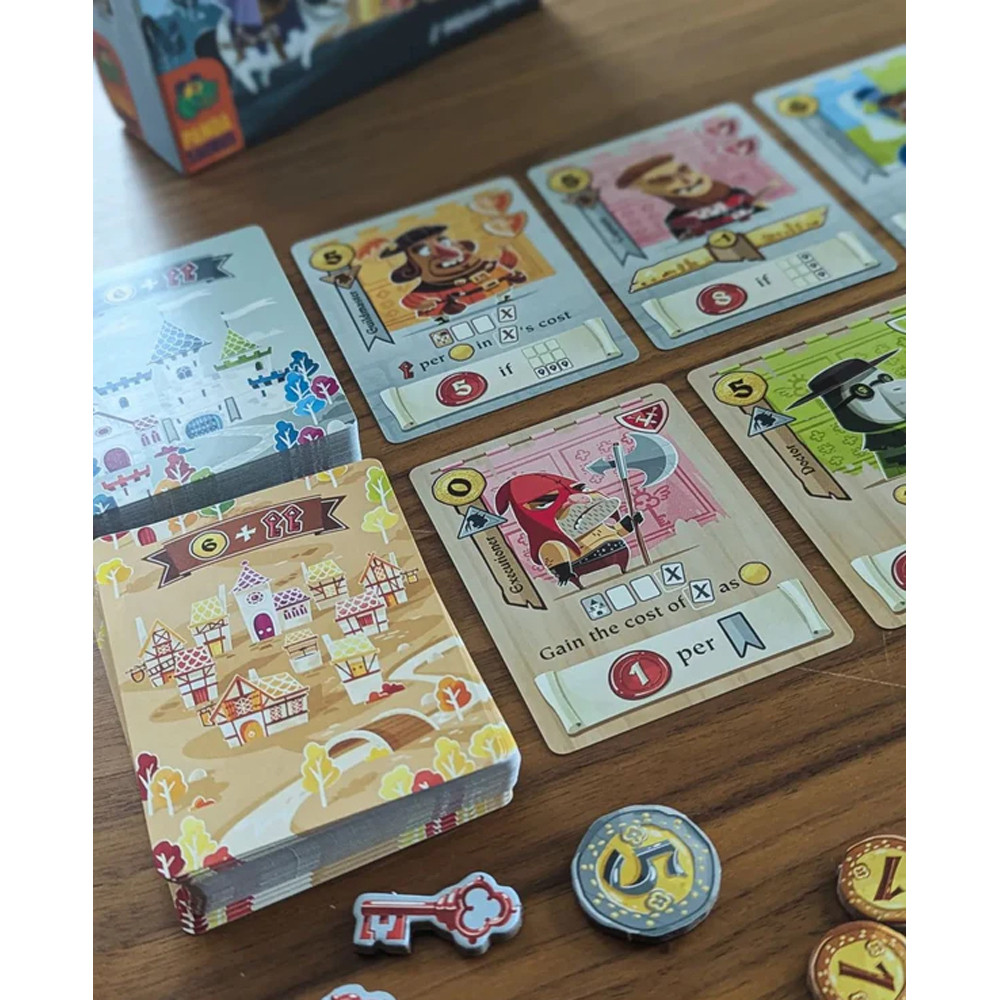Castle Combo is the latest in Pandasaurus’s line of imports of smaller-box titles from Europe, following previous hits Sea Salt & Paper and Faraway (the latter of which made my top ten games of 2024). It’s a tableau-builder with a few quirks to the selection mechanism to distinguish it enough from the flood of similar titles on the market, and does share some DNA with Faraway in the way it ultimately scores. It’s from two designers who have another game coming out later this year called Zenith; one of the pair, Grégory Grard, co-designed the 2023 game In the Footsteps of Darwin, which earned a Spiel des Jahres nomination, but which I didn’t care for much because it had about as much to do with Charles Darwin as Monopoly does.
Players in Castle Combo will select nine cards to build 3×3 tableaux in front of them, taking one card from the six on display in each turn. The display itself is split into two rows, one of cards with grey/silver backs and one of cards with tan backs, and you may only select from the row where the messenger token sits. Each card has a cost in coins from 0 to 7?, one or two shields in any of the game’s six colors, an immediate power or benefit, and an end-game scoring function. Players begin the game with 15 coins and 2 keys; you can spend one key per turn to either move the messenger to the other row in the display, or to refresh the three cards in the current row with new ones.
Selecting some cards moves the messenger to the other line
Those immediate powers can give you coins or keys – more on those in a moment – usually based on what else is in your tableau already, or other benefits like 1 coin discounts on silver -or tan-backed cards. The end-game scoring is much broader, as nearly all cards give you some number of points per something else in that row, or column, or your tableau as a whole, or where you placed the card, or if some shield color is missing, or too many other things to list. It would be such a point-salad disaster if it weren’t limited to just nine cards all neatly arrayed in a square.
If you can’t afford any cards, you must take one and play it face-down for 6 coins and 2 keys, receiving 0 points for it at game end. After the ninth round, players score all of their face-up cards according to the rules on each. Leftover coins have no value unless the player has ‘purse’ cards on which you can store gold during or after the game; coins not in purses do come into play as the tiebreaker. Leftover keys are worth 1 point each.
There isn’t a ton of player interaction here, which is fine given the number of things you have to track and consider on your turns. Before choosing a card, you have to see how many coins you have and how many you’ll have afterwards (since many cards give you coins back), and then consider its immediate and end-game effects while also figuring out the optimal place for it in your tableau. Actually, you’ll do that for many or all of the six cards on the market at that time; trying to also figure out, say, which cards your opponents might want, or which ones might hurt them more, would be overload for a game of this weight.
The theme doesn’t tie all that well to the game, although I appreciate the comic nature of the art on the cards. You’re supposed to be collecting characters from the upper and lower classes of your city to come live or work at your castle, but even though each card has a character type I find I play without ever even looking at the text. It’s all about the abilities and how they fit into my tableau at that point or will determine my strategy for cards going forward.
Castle Combo plays 2-5 players and promises playing times of 10-25 minutes; I think 10 minutes might apply to a game of two players who’ve played a few times before, but the 25 minutes is probably about right as an upper bound. You only have nine turns and you have just a few choices on each turn, so even though you will find you’re putting a lot of thought into each buying decision, there’s only so much of that you can do before the next player smacks you in the back of the head. I do prefer Faraway, which has a similar weight, playing time (eight turns per player), and even box size, because its main mechanic is more novel. Castle Combo takes a lot of aspects of other games and skillfully smooshes them together into a smart filler-game experience.
